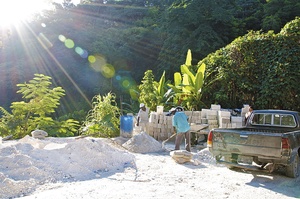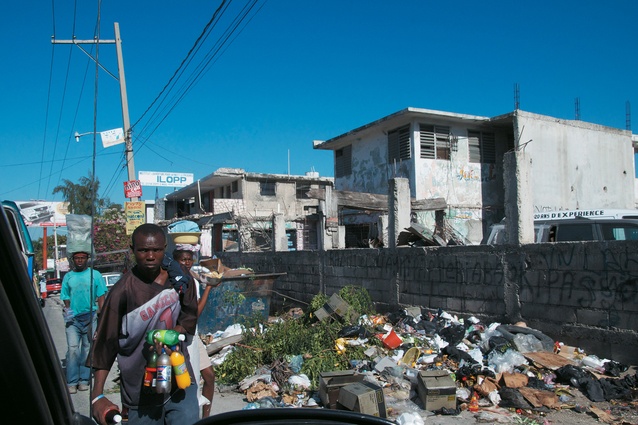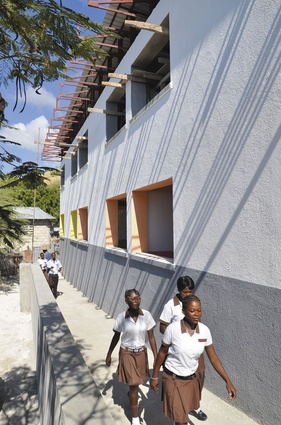The Haitian experience
Six Auckland-based architecture students describe their experiences in Haiti, while working on projects for NGO Architecture for Humanity.
Rubber burned somewhere in the distance and the heat provoked our jet lag as we sifted through luggage piled on the floor of the airport shed. Bags in hand, we anxiously pushed through porters and ‘touts’ – aching to convince us that we needed any service they happened to be offering – into the sanctuary of a roughed-up four-wheel drive. As our driver pulled away from the airport, our senses drowned our minds in a wash of crowded, chaotic streets, crumbling buildings still clinging to their bright paint, stray dogs barking, ‘tap taps’ (or share taxis) piled high with Haitians trying to go somewhere, quick-stepping chickens, lawless freestyle driving, slender coconut palms, mango trees and never-ending street vendors – in Haiti, if you have two of something, you have a business. The one constant of the journey is the rubbish; pervasive and depressing, it clogs the streets, drains and rivers of the capital city. We arrived at the Architecture for Humanity offices in Pétionville, Port-au-Prince, simultaneously stunned and excited, the first of many contrasts to come.
Haiti is not a country you can come to and fix. Even before the catastrophic 7.0 earthquake that devastated the island on 12 January 2010, it was considered the poorest country in the Western hemisphere. The Haitians have suffered through decades of corrupt dictatorships and coups, and survive only through a long-term dependence on foreign aid. They have always needed infrastructure: the simple basics like clean drinking water, roads, sanitation, rubbish disposal, schools and hospitals. After the earthquake, an already bad situation became unimaginable.

The United States Agency for International Development has estimated that as many as 1.8 million people lost housing that January afternoon as the epicentre hit just 25km away from half of Haiti’s population in Port-au-Prince. Oxfam recently reported that only 5 per cent of the rubble has been cleared. The loss of life cannot be conveyed. What felt like hyperbole on a web page became reality in our stomachs as we walked the streets of Port-au-Prince. Piles of rubbish and concrete were ubiquitous, some streets jutted up into the air, almost impassable even by foot, dangerous debris hung from pieces of steel. Almost two years later, it looked like the earthquake happened just yesterday.
Nothing is quick or easy in Haiti, and the non-government organisations (NGOs) who get that understand the goal is long-term change. Architecture for Humanity is one of those NGOs whose effectiveness stems from the knowledge that Haitians have struggled with past governments and are jaded by aid organisations offering quick fixes. Having previously worked in over 25 countries around the globe, this non-profit design firm has dealt with a complete lack of trust before. Eric Cesal, regional programme manager, believes the focus should be on the role of architects as facilitators of economic, social and physical forces. Especially here, where one million people still live in tents, the building is not the end goal; the beneficial effect the building has on a community becomes the measure of architecture’s success.
Architecture for Humanity knows that Haiti must fix itself and works with different inexperienced construction crew for each project; while frustrating and slower in the short term, the effort educates an industry. Bati Byen, the organisation’s new project centre in Port-au-Prince, not only trains but also pays locals to envision and build their own buildings in a safe and ethical way. They are on schedule to build nine schools, as education on every level is fundamental to recovery and it’s what brought us, six architecture students from Unitec – Arnika Blount, Gabriel Fung, Elfie Kitchingham Hamilton, Samuel Morris, Marcus Richardson and Courtney Smith Frank – and our lecturer, Mark Mismash, NZIA, together with Architecture for Humanity for its Haitian efforts. We came here expecting to do some drawing and maybe swing hammers but have come away with a deeper understanding of the processes involved in developing architecture at a humanitarian scale. We spent long, hot days (always in groups of three or more, for security reasons) mapping details of informal settlements in Port-au-Prince, and several towns in the south, with a view to future improvement. We developed a vision document for a school in Montrouis, an extensive site model so residents could visualise their project in Villa Rosa, and positioned water wells in a starter home settlement outside of Léogâne.
 Haiti is a land of contrasts: children walk to school in crisp, clean, brightly coloured uniforms against a backdrop of filth; teenagers pump water with one hand while texting with the other (there are no landlines); private beaches out of the pages of a travel brochure exist within sight of sand covered in broken glass and plastic bottles floating in the clear, blue water. But underneath the chaos lies a geographically stunning country; Haitians know this. This is the land and sea where their fathers, and their fathers before them, lived their lives. They form very tight communities made from little more than tarpaulin and canvas; as time has taught them they can rely only on themselves. A new government bred from these experiences leads these communities now and, as a result, organisations like Architecture for Humanity can make even more of an impact.
Haiti is a land of contrasts: children walk to school in crisp, clean, brightly coloured uniforms against a backdrop of filth; teenagers pump water with one hand while texting with the other (there are no landlines); private beaches out of the pages of a travel brochure exist within sight of sand covered in broken glass and plastic bottles floating in the clear, blue water. But underneath the chaos lies a geographically stunning country; Haitians know this. This is the land and sea where their fathers, and their fathers before them, lived their lives. They form very tight communities made from little more than tarpaulin and canvas; as time has taught them they can rely only on themselves. A new government bred from these experiences leads these communities now and, as a result, organisations like Architecture for Humanity can make even more of an impact.
Eric explained that “the sharing of knowledge, expertise and commitment is the world’s most valuable tool in addressing the effects and causes of natural disaster. To that end, Unitec students brought with them a charged passion about their investigations and work. They helped [us] with critical work that will form the basis of much of our work in 2012. We were very blessed to have them.”
Through our work here, and the resilient people of Haiti, we know now that architecture has a real, fundamental purpose.
The students are grateful for the support of the New Zealand architectural community. For more information about the students’ work and experiences in Haiti, visit archstudentsforhumanity.wordpress.com
Four projects
The work with Architecture for Humanity involved four projects; the first project involved the mapping of small towns on the south and south-west side of the island. Currently, the only maps for these areas are based on satellite imagery and do not contain the type of information required by NGOs to make decisions. The students’ task was to survey these smaller, remote locations, gather information and load that information on open-sourced internet-based mapping systems (Open Street Map). The information will also be integrated in the first GIS map of these areas.
The areas surveyed are of particular historic significance in relation to the exploration of the Western hemisphere by Europeans. The Ile-à-Vache is claimed to be the first place Christopher Columbus made landfall in the Western world and the documented villages are some of the earliest Spanish outposts in the Caribbean, established before 1500. The students made two trips to the southern towns, totalling six to eight days in the field. They surveyed the largest of the towns, Aquin, followed by Saint-Louis-du-Sud, Cavaillon, Maniche and Ile-à-Vache. The three other projects involved new construction (onsite), masterplanning and research documentation.
The ultimate pop-up
“Haitians are incredibly entrepreneurial. Last week, a large track hoe was excavating limestone from a site next to the road. Within a couple of days, a pop-up shop selling concrete masonry unit (CMU) blocks appeared on the side of the road. Workers were cleaning up the rubble from the excavation site, carting it to an open lot across the street, grading it through screens, separating it into piles and recombining the mix with Portland cement so that it could be formed into concrete blocks. I can’t comment on the quality of the block but I admire the initiative of these Haitians who saw opportunity in what I might consider waste.”
Abridged from Mark Mismash’s blog.
Earthquakes don’t kill people, bad buildings do
“The complete lack of quality control on building sites and in places like the concrete-block pop-up shop has resulted in buildings where the grout is in fact stronger than the concrete blocks (walls becoming a network of grout and crumbled/absent blocks after the earthquake). Even a layer of concrete plaster (crepisage) can add 15 per cent to the structural strength of these buildings. Lack of money equals low-quality construction materials. Buildings built in stages over a long period of time equals inconsistency in types of materials, which equals weak points within the structure.”
Abridged from Arnika Blount’s blog.
The traditional Haitian house
“The kay is the traditional Haitian house. I haven’t seen many within Port-au-Prince, where a tidal wave of concrete masonry has taken control, but they are much more common in small provincial towns. Ti-kays are long, thin houses, free-standing to aid ventilation and with a front porch that inevitably faces the road and seems to play an essential role in the social life of its inhabitants. The overhanging front gable is, in fact, a storage loft and the kay can easily be added to off the back. I sketched a kay situated down a side road in Santo; it caught my eye while we were on the way to visit Architecture for Humanity’s Santo project. These old timber buildings are generally in a dilapidated state, with pieces of fretwork missing and faded pastel or turquoise paint, but they ooze charm from every knothole and there is hardly a right angle to be seen. “Perhaps the conversion of the Haitian housing stock from timber construction to concrete masonry was a side effect of deforestation, which is a major issue in Haiti. Over a period of about 85 years, the forested land in Haiti dropped from 60 per cent to 2 per cent. You can imagine the problems this has caused.”
Abridged from Arnika Blount’s blog.
Article courtesy of Unitec students– Arnika Blount, Gabriel Fung, Elfie Kitchingham Hamilton, Samuel Morris, Marcus Richardson, Courtney Smith Frank and their lecturer, Mark Mismash.















